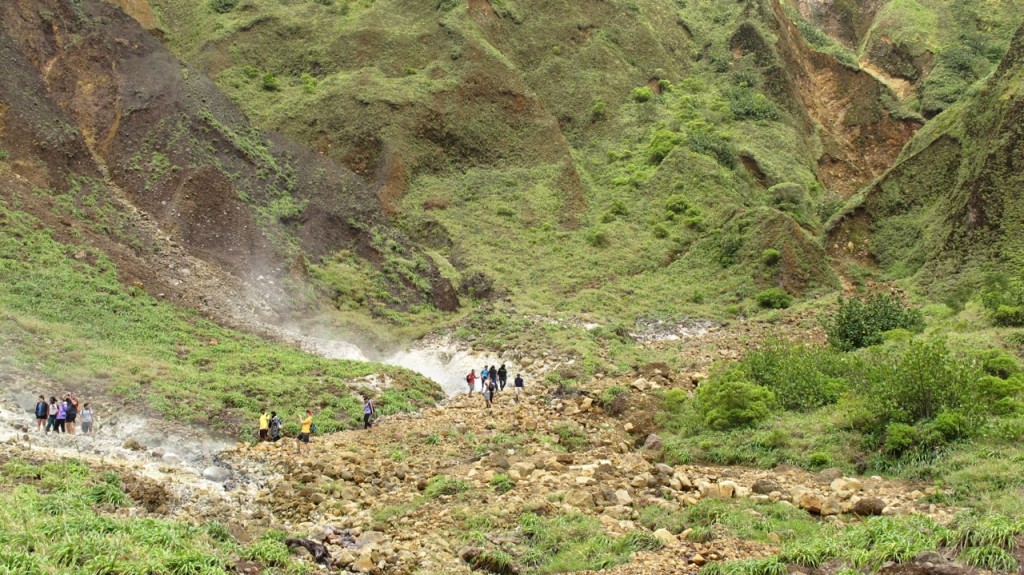
The Boiling Lake
The most famous of Dominica’s trails, the Boiling Lake is a flooded fumarole reached after a hard 3-4 hour hike (one-way) from the village of Laudat. But it’s well worth it – the Lake is a cauldron of bubbling greyish-blue water that is usually enveloped in a cloud of vapour. The lake is known as the world’s second largest boiling lake, at approximately 200 ft (63m) across.
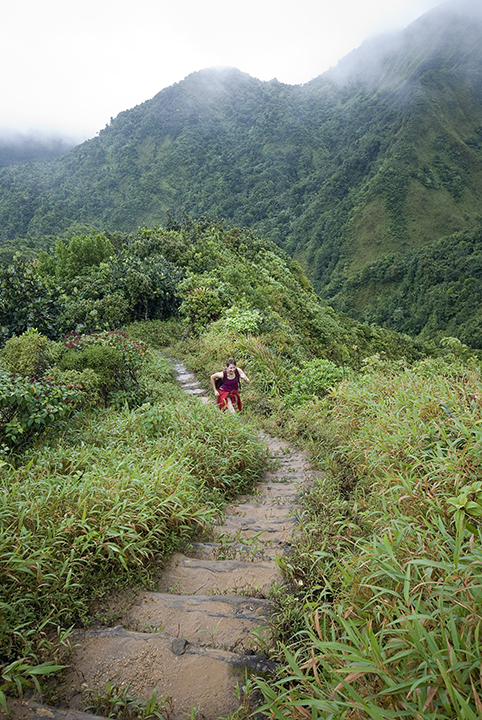
A Little History
The first recorded sighting of the Lake was in 1870 by Mr. Watt and Dr. Nicholls, two Englishmen working in Dominica at that time. In 1875, Mr. H. Prestoe, a government botanist, and Dr. Nicholls were commissioned to investigate this natural phenomenon. They measured the water temperature and found it to range from 180 to 197 degrees Fahrenheit (82 – 91.5 Celsius) along the edges, but could not measure the temperature at the centre where the Lake is actively boiling. They recorded the depth to be greater than 195ft (59m).
A later report indicated that apparently the water level of the lake dropped and a geyser developed in the lake’s centre. The geyser spewed water and mud to 60ft (18m) and higher, building a pumice cone at its base and filling the bottom of the lake. A photograph taken in 1895 when the Boiling Lake was ‘dry’ showed the water level 30-50 feet below the water line. In April 1988, the lake stopped boiling. intermittently, and the level dropped by 29 feet. It has since returned to its normal conditions.
The Trail

Any page about The Boiling Lake trail should start with the cardinal rule: first and foremost go with someone who knows the way well. You can get a guide when you get to the usual launching point – Laudat – or you can ask around in Roseau in the days before you go or organise it through your hotel. The trail is for the most part well defined and it is tempting to set out on one’s own. But since much is along a razor-thin ridge and there are other parts where you’re scrambling over rocks, the experience of One Who Knows The Way is without price (but will usually cost you about EC$150 per person).
The trail itself is around eight miles. Officially it’s around a three-hour walk each way, and that amount of time should be allowed for; do not start the hike after midday. The going is not, in horse racing terms, Good to Firm. ‘Extremely Muddy’ describes it better. Which leads into cardinal rule number two: wear your scruffiest clothes. The problem is that few people travel on their dream holiday to the Caribbean with the kind of clothes they’d mow the lawn in or paint the house. Nethertheless, I’ve seen many good (brand new, even) training shoes totally ruined by a trip to The Lake. Good walking boots are best, but any firm & comfortable shoe should suffice.
Next tip: schedule the trip so that the following day is a ‘beach day’. That is, will put no demands on your body whatsoever. Such as can be had lying in the sun, or in the office.
The Hike

The Lake is reached by a 2 – 4 hour walk from the village of Laudat.
Part I: Titou Gorge to Breakfast River
Time taken: Approx 1 hour
The starting point for the trail is Titou Gorge (1,690ft). The path climbs steadily for about 45 minutes, and there are one or two points early on where you can (carefully) look down on the Gorge. This is perhaps the muddiest part of the hike. As you descend to the Breakfast River there is a good viewpoint looking up the river.
The Breakfast River is traditionally the first stop, where one takes a breather and eats breakfast. It is good to gain some energy as it’s uphill immediately thereafter and for the next hour. This is the last spot for clean drinking water, so fill up!
Part II: Breakfast River to the top of the Valley of Desolation
Time taken: Approx 1 hour
From the ascent of Breakfast River, it is steeply uphill to about 2,500ft, then a steady SE climb along the ridge to the top (3,168ft) where’s there’s a clearing and a good point to stop and rest. On a sunny day it can provide spectacular 360° views. Coming back it at least represents the epitome of the ‘it’s all downhill from here’ attitude (although it’s not). The trail goes onwards for about 20 minutes to the top of the Valley of Desolation. As you descend the ridge, on your left side in a distance you can grab your first views of the steam rising from The Lake.
Part III: The Valley of Desolation to The Lake
Time taken: Approx 1 hour
From the ridge, the trail descends steeply into The Valley of Desolation.
The Valley is not covered by an ice-thin crust that can crack open and devour the unsuspecting (although one should certainly explore it with caution). It is perhaps better than The Lake, because you can scamper around and see all the different colours you never imagined water could be. A kind of interactive vulcanism lesson.
Look also for the Fumarole Vegetation – the only kind of vegetation that can survive in this environment
At the bottom of the Valley the trail becomes vague, crossing and recrossing the stream, so be careful.
There are several places where you can bathe in the soothing warm waters of the stream, but don’t spend too much time soaking – you don’t want your muscles to become all mushy for the long hard hike back afterwards!
From the Valley it’s generally uphill to a point where one can look down on another area of ‘Desolation’. The Lake is just 15 minutes away there!
Part IV: The Lake
Elevation: 2,640ft
Exercise extreme caution at the lake: the sides are steep and though the hill above the lake offers the best views, the rocks are often very slippy.
Today the Lake appears like a cauldron of bubbling greyish-blue water that is usually enveloped in a cloud of vapour. The lake is approximately 200ft (63m) across and its present depth is unknown. The side of the lake are a mixture of clay, pumice and small stones.
It is believed that the Lake is actually a flooded fumarole, a crack through which gases escape from the molten lava below, rather than a volcanic crater. The natural basin of the Boiling Lake collects the rainfall from the surrounding hills and from two small streams which empty into the lake. The water seeps through the porous bottom to the hot lava below where it is trapped and heated to boiling point.
The Way Home
Before you know it, you’re on The Return Journey. And isn’t it funny how one no longer cares about getting muddy?
Think only of the adventurous swim up the Titou Gorge to complete the end of your hike or the hot meal that may await you. If you would like to soothe your muscles, hop over to the next valley, Wotten Waven, where you have your choice of many different hot springs, and reward yourself with a relaxing and rejuvenating soak in the warm pools…. and maybe even with a rum punch!
The Perfect Backpack
For hiking in Dominica, my favourite backpack is a waterproof one. It's not only great for hiking in the rainforest, you can take it along on a kayaking trip, whale-watching, or to the beach to keep things sand-free & dry. Check out this MarsBro Waterproof Backpack on Amazon.
Note that as an Amazon Associate I earn from qualifying purchases.
Tips for the Hike
Wear comfortable clothing. It will be humid – and muddy!
- Shorts or light pants
- Sturdy sandals, sneakers with good treads or hiking boots
There is one river crossing so be prepared to get your feet wet!
The hike can take up to 6 hours, so be aware of when it will get dark.
Remove any gold/silver jewelry – it may tarnish due to the sulphur.
What to take:
- Waterproof rain gear (a poncho protects camera gear)
- Camera with extra batteries, and somewhere dry to keep them.
- Plenty of water
- Snacks
- Leave at least a clean t-shirt or a change of clothes in your vehicle for when you finish
What to look out for
- Sisserou or Jaco Parrots
- Mountain Whistler (montagne siffleur)
Geology
Learn more about the Geology of Dominica
Hot Pools
Learn more about the Geology of Dominica
The Un-Boiling Lake
Authorities at the Office of Disaster Management (ODM) and the Forestry Division have warned to refrain from going to the Boiling Lake as there has currently been activity involving frequent changes in water levels and temperature.
This phenomenon has taken place seven times in the past recorded history – 1876, 1900, 1901, 1971, 1988, 2004 and recently on November 8, 2016 when visitors to the Boiling Lake reported that it had drained again. During these episodes, harmful gases, such as Carbon Dioxide, can be released and small steam explosions may also occur.
Despite the present drop in water temperature, swimming is never allowed in the Boiling Lake. The water can return to its original boiling state with little or no warning, and can be to harmful and dangerous.
The local officials, together with the Trinidad-based Seismic Research Center of the University of the West Indies, continue to monitor the situation at the Boiling Lake.
Fluctuations in the Lake's water level
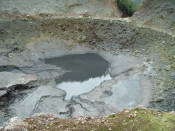 The Dry Lake in 2004
The Dry Lake in 2004
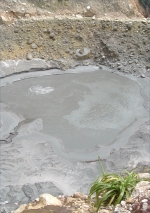 Lake filling up in 2005
Lake filling up in 2005
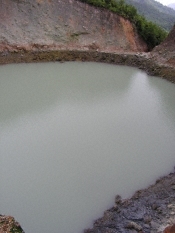 Lake mid 2005
Lake mid 2005
Do I need a guide?
Yes! There are points where the track is indistinct, or takes a sharp turn up a hill when you least expect it to. This is why a guide is recommended. Find a Guide here.
More About the Boiling Lake
- Many hikers and celebrities have gone to the Boiling Lake – see our archives of photos taken on Boiling Lake Hikes from 1999 to 2004.
- The Boiling Lake: An article published in The Guardian June 21, 2000, by Polly Pattullo.
- Dominica’s Boiling Lake makes list of “14 Questionable Things About U.S. Lakes (9 Around The World Even More Bizarre) November 2018.


